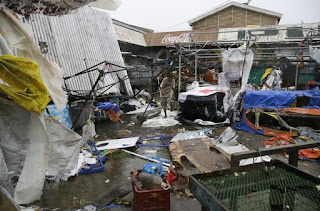At Least 12 Dead As Typhoon Mangkhut Reaches Philippines
At least 12 people have been killed after Typhoon Mangkhut slammed into the north-eastern coast of the Philippines.
Mangkhut, which was downgraded from a super typhoon, slammed into Luzon Island on Saturday morning, with ferocious winds and blinding rain ripping off tin roof sheets and knocking out power.
Most of those who died were caught up in landslides or houses which collapsed, according to authorities.
At least two children are among the dead.
More than five million people were at risk from the storm, which the Hawaii-based Joint Typhoon Warning Centre downgraded from a super typhoon but said was still punching powerful winds and gusts equivalent to a category four Atlantic hurricane.
Around 87,000 people have been evacuated from high-risk areas.
 |
Gusts were equivalent to a category four hurricane |
With a huge rain cloud band 560 miles wide, combined with seasonal monsoon rains, the typhoon dumped intense rain that could set off landslides and flash floods.
Storm warnings have been raised in almost all the provinces across the Luzon, including the capital, Manila, restricting sea and air travel.
 |
Residents walk along destroyed stalls at a public market in Tuguegrao city. Credit: AP Photo/Aaron Favila |
A few hours after landfall, the eye of the typhoon was nearing the western coast of Luzon facing the South China Sea.
Before it hit land, Mangkhut packed sustained winds of 127mph and gusts of up to 158mph, forecasters said.
In Tuguegarao, residents braced for the typhoon’s fury by reinforcing homes and buildings and stocking up on food.
“It was busy earlier in the hardware store and people were buying wood, nails, tin wire, plywood and umbrellas,” said Benjamin Banez, who owns a three-story hotel where workers were busy hammering up wooden boards to protect glass panels.
In 2016, a super typhoon wrought heavy damage to Mr Banez’s hotel and the rest of Cagayan.
Ninia Grace Abedes abandoned her bamboo hut and hauled her four children to a school building serving as an emergency shelter. The 33-year-old laundrywoman said the 2016 typhoon blew away their hut, which they abandoned before the storm hit.
“If we didn’t, all of us would be dead,” she said.
More than 15,300 people had been evacuated in northern provinces by Friday afternoon, the Office of Civil Defence said.
Concerns over massive storm surges that could be whipped inland by the typhoon’s winds prompted wardens to move 143 detainees from a jail in Cagayan’s Aparri town to nearby towns, officials said.
After the Philippines, the Hong Kong Observatory predicts Mangkhut will aim at the Chinese mainland early on Monday south of Hong Kong and north of the island province of Hainan.
 |
| Thousands of people have taken up temporary residence. |
Thousands of people have taken up temporary residence. Credit: AP
The observatory warned of rough seas and frequent heavy squalls, urging residents of the densely populated financial hub to “take suitable precautions and pay close attention to the latest information” on the storm.
The gambling enclave of Macau, near Hong Kong, suffered catastrophic flooding during Typhoon Hato last August that left 10 dead and led to accusations of corruption and incompetence at its meteorological office.
On the Chinese mainland, the three southern provinces of Guangdong, Guangxi and Hainan are coordinating preparations, including suspending transport and moving people to shelter inland, the national meteorological agency reported.
Philippine forecasters said the shifting typhoon could possibly blow towards Vietnam after it exits late on Saturday or early on Sunday.
Mangkhut, the Thai word for mangosteen fruit, is the 15th storm this year to batter the Philippines, which is hit by about 20 a year and is considered one of the world’s most disaster-prone countries.





























No comments:
Post a Comment